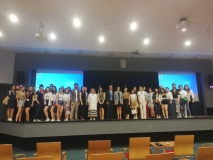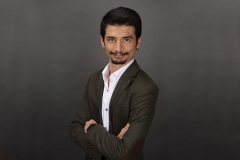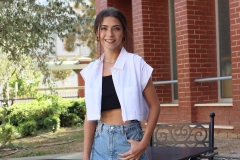
VOCATIONAL SCHOOL OF HEALTH SERVICES
Department of Physiotherapy
FYT 106 | Course Introduction and Application Information
| Course Name |
Kinesiology and Biomechanic
|
|
Code
|
Semester
|
Theory
(hour/week) |
Application/Lab
(hour/week) |
Local Credits
|
ECTS
|
|
FYT 106
|
Spring
|
2
|
0
|
2
|
3
|
| Prerequisites |
None
|
|||||
| Course Language |
Turkish
|
|||||
| Course Type |
Required
|
|||||
| Course Level |
Short Cycle
|
|||||
| Mode of Delivery | face to face | |||||
| Teaching Methods and Techniques of the Course | DiscussionQ&ALecture / Presentation | |||||
| Course Coordinator | ||||||
| Course Lecturer(s) | ||||||
| Assistant(s) | - | |||||
| Course Objectives | Students in this course; is aimed to gain the students the skill about relationship between the contents of the course and clinical work, basic knowledge on mechanics/pathomechanics of movement, how to use the knowledge of mechanics to assess the movement, joint-bone-muscle-cartilage and collagen tissues, equilibrium, gravity, coordinates and orientation planes, normal gait, determinants of gait and gait analysis, competency to relate clinical situations to movement science. |
| Learning Outcomes |
The students who succeeded in this course;
|
| Course Description | This course includes; movement and mechanical principles, mechanical and pathomechanics of the bone, muscle, collagen, and cartilage tissue, mechanical properties of the joints of the body, equilibrium, orientation planes and coordinates, normal and pathological gait. |
|
|
Core Courses |
X
|
| Major Area Courses | ||
| Supportive Courses | ||
| Media and Management Skills Courses | ||
| Transferable Skill Courses |
WEEKLY SUBJECTS AND RELATED PREPARATION STUDIES
| Week | Subjects | Related Preparation |
| 1 | Introduction to the kinesiology and biomechanics | Şener G, Erbahçeci F, Kinezyoloji ve Biyomekanik. Hipokrat Kitabevi; s.1, 2016, Ankara |
| 2 | Bone tissue / Functional compatibility of bone in pathological conditions | Şener G, Erbahçeci F, Kinezyoloji ve Biyomekanik. Hipokrat Kitabevi; s.35-90, 2016, Ankara |
| 3 | Metabolic bone diseases | Şener G, Erbahçeci F, Kinezyoloji ve Biyomekanik. Hipokrat Kitabevi; s.129-164, 2016, Ankara |
| 4 | Muscle tissue / contractures and fatigue | Şener G, Erbahçeci F, Kinezyoloji ve Biyomekanik. Hipokrat Kitabevi; s.185-244, 2016, Ankara |
| 5 | Connective tissue / Collagen fibers, cartilage and Joint | Şener G, Erbahçeci F, Kinezyoloji ve Biyomekanik. Hipokrat Kitabevi; s.565-601, 2016, Ankara |
| 6 | Reference planes of the body, coordinate system and balance | Şener G, Erbahçeci F, Kinezyoloji ve Biyomekanik. Hipokrat Kitabevi; s.453-504, 2016, Ankara |
| 7 | Movement analysis / Normal and Pathological gait | Şener G, Erbahçeci F, Kinezyoloji ve Biyomekanik. Hipokrat Kitabevi; s.333-422, 2016, Ankara |
| 8 | Midterm Exam | |
| 9 | Columna vertebralis and its pathomechanics / scoliosis | Şener G, Erbahçeci F, Kinezyoloji ve Biyomekanik. Hipokrat Kitabevi; s.287-332, 2016, Ankara |
| 10 | Hip and Pelvis mechanics and pathomechanics | Şener G, Erbahçeci F, Kinezyoloji ve Biyomekanik. Hipokrat Kitabevi; s.287-332, 2016, Ankara |
| 11 | Knee mechanics and pathomechanics | Şener G, Erbahçeci F, Kinezyoloji ve Biyomekanik. Hipokrat Kitabevi; s.287-332, 2016, Ankara |
| 12 | Foot / ankle mechanics and pathomechanics | Şener G, Erbahçeci F, Kinezyoloji ve Biyomekanik. Hipokrat Kitabevi; s.287-332, 2016, Ankara |
| 13 | Shoulder / Arm complex, Elbow joint, Hand / wrist joint | Şener G, Erbahçeci F, Kinezyoloji ve Biyomekanik. Hipokrat Kitabevi; s.287-332, 2016, Ankara |
| 14 | Semester review | |
| 15 | Semester review | |
| 16 | Final Exam |
| Course Notes/Textbooks | Şener G, Erbahçeci F, Kinezyoloji ve Biyomekanik. Hipokrat Kitabevi; 2016, Ankara |
| Suggested Readings/Materials | Cael C. Fonksiyonel anatomi : manuel terapistler için kas iskelet anatomisi, kinezyoloji ve palpasyon Ankara : Nobel Tıp Kitabevleri, 2015 ISBN 0-7817-7404-7 |
EVALUATION SYSTEM
| Semester Activities | Number | Weigthing |
| Participation | ||
| Laboratory / Application | ||
| Field Work | ||
| Quizzes / Studio Critiques |
2
|
20
|
| Portfolio | ||
| Homework / Assignments |
1
|
10
|
| Presentation / Jury | ||
| Project | ||
| Seminar / Workshop | ||
| Oral Exams | ||
| Midterm |
1
|
30
|
| Final Exam |
1
|
40
|
| Total |
| Weighting of Semester Activities on the Final Grade |
4
|
60
|
| Weighting of End-of-Semester Activities on the Final Grade |
1
|
40
|
| Total |
ECTS / WORKLOAD TABLE
| Semester Activities | Number | Duration (Hours) | Workload |
|---|---|---|---|
| Theoretical Course Hours (Including exam week: 16 x total hours) |
16
|
2
|
32
|
| Laboratory / Application Hours (Including exam week: '.16.' x total hours) |
16
|
0
|
|
| Study Hours Out of Class |
14
|
1
|
14
|
| Field Work |
0
|
||
| Quizzes / Studio Critiques |
2
|
5
|
10
|
| Portfolio |
0
|
||
| Homework / Assignments |
1
|
5
|
5
|
| Presentation / Jury |
0
|
||
| Project |
0
|
||
| Seminar / Workshop |
0
|
||
| Oral Exam |
0
|
||
| Midterms |
1
|
12
|
12
|
| Final Exam |
1
|
17
|
17
|
| Total |
90
|
COURSE LEARNING OUTCOMES AND PROGRAM QUALIFICATIONS RELATIONSHIP
|
#
|
Program Competencies/Outcomes |
* Contribution Level
|
||||
|
1
|
2
|
3
|
4
|
5
|
||
| 1 | To have the required contemporary theoretical and practical knowledge in his/her field |
X | ||||
| 2 | To use the material and technology related to his/her field, and make their maintenance, use the information and communication technologies at basic level |
|||||
| 3 | To have the competency to recognize the problems in his/her field, analyze them, develop evidence-based solutions and have the ability to share their suggestions with others |
X | ||||
| 4 | To be aware of legal responsibilities, conduct basic studies in her/his field independently |
|||||
| 5 | To communicate with patients, relatives and colleagues properly, comprehensively, honestly and explicitly, transfer his/her thoughts and knowledge through written and oral communication |
|||||
| 6 | To take responsibility as an active team member during the practices in his/her field |
|||||
| 7 | To commentate and evaluate the scientific information with a critical approach by the help of knowledge gained in his/her field |
X | ||||
| 8 | To comprehend the importance of lifelong learning, to determine and meet her/his learning needs, to develop herself/himself by monitoring the development in science and technology |
|||||
| 9 | To act by considering the universal ethical values, social and cultural characteristics |
|||||
| 10 | To know the concepts of occupational safety, patient safety, environmental protection and quality, and fulfill the requirements |
|||||
| 11 | To be able to follow information in his field and communicate with colleagues in English at least a level of European Language Portfolio A2 General Level |
|||||
| 12 | To know the legal aspects of the field of physiotherapy, and work within this framework |
|||||
| 13 | To determine the needs of the induviduals under their responsibility and carry out activities for development |
|||||
*1 Lowest, 2 Low, 3 Average, 4 High, 5 Highest



